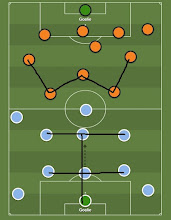The blocking behind the wall to defend free kick, surprisingly did not begin at the top flight competition.
Blocking the free kick behind the wall, either by lying down or simply kneeling, has been common to see in modern football matches. Almost all teams are using this unusual defensive trick to block the low-driven shot in free kicks, particularly those aimed through the wall while the defenders jump, creating a space to shoot and stun the opponents.
The Origin
Such might be rather unorthodox but it has proven to be effective. It is believed that the origin can be traced down to the land of magical Jogo Bonito football, Brasil, despite the fact that it has become viral and well known worldwide due to Inter Milan’s Marcelo Brozovic’s stunning action in 2018.
It is not
surprising that such a trend began in Brazil, as the low-drive free kick was
also invented by one of Brazil's modern football maestros, Ronaldinho. In the
group stage of the UEFA Champions League 2006/07, the former Barcelona winger
fooled Werder Bremen's defensive wall with such a free kick and beautifully
found the back of the net. Brasilian talisman's attempt to repeat such ploy in
2011 Brasilian Championship against
That particular free-kick goal has become memorable, and it has naturally left extra homework for the defensive lines on how to avoid getting conceded in a similar way. Several other players attempted to replicate the former Barcelona star, such as Parana’s Lucio Flavio and Palmeiras man Jorge Valdivia. It was against the latter executor that scheme began.
Back in 2013, Ricardinho, a midfielder from a lesser known team in Brasilian second tier, Figueirense, had thought it through before the game against Palmeiras, where Jorge Valdivia was their main free kick taker. At that time, the Brasilian giant was just relegated from Brasilian Serie A in the previous season. He eventually came up with the idea of lying down behind the wall, which appeared to stun his teammates as he did not communicate his idea in advance. Despite his pointless but risky effort, as the Chilean international chose a normal free kick over a low drive one, his manager, Adilson Batista, praised him.
Its Evolution
That manoeuvre
was later developed and began to be used in international matches by Real
Madrid defender Marcelo, who modified it by kneeling behind the wall rather
than lying down against Argentina in November 2016 during the 2018 World Cup
qualifiers. Not long after Marcelo's action, another Brazilian star, Phillipe
Coutinho, did the same against Tottenham while still playing for Liverpool.
Prior to being adopted by Brozovic, Juan Mata tried this technique in the 2017
Europa League final against Ajax, though not fully lying down.
Since Marcelo Brozovic made it popular in the 2017/18 season, the low-driven free kicks seem to be no longer an option for the free kick takers today. Such does not prevent them from scoring through this dead-ball position. The executors would opt for different scenarios from kicking the ball through the gap between the walls and high curling shots aimed at the corner of the opponent's goal. Argentine star and skipper, Lionel Messi had attempted it against Athletic Bilbao in the 2020/21 season and succeeded.
Perhaps Diego
Maradona's sharp curling free kick against Juventus in the 1984/85 season or
David Beckham's long curling one as a dramatic equaliser against Greece in the
2002 World Cup qualifying round would be a great reference because it was a
beautiful but lethal shot with a slight element of surprise. Such kind of free kick would be still be challenging to block, either by heading or more conventional yet aggressive way.


Comments
Post a Comment